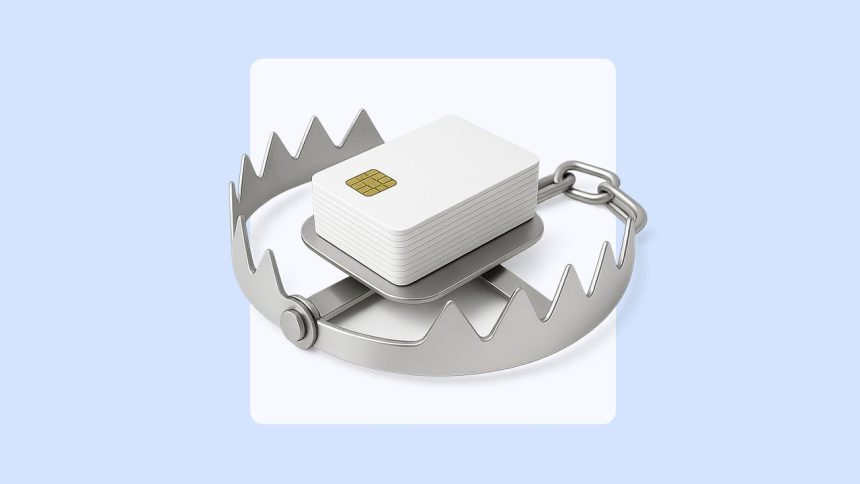Key takeaways
- Predatory cards are often viewed as a last resort for those with the worst credit scores.
- These cards are known for sky-high interest rates, lower credit limits and myriad fees.
- Stronger credit-building options exist, even for those with poor credit.
- Help is available for those unable to pay off their card balances.
A bad credit score doesn’t just leave you struggling with high interest rates and limited financial options. It can also make you a target.
Credit card issuers specifically design so-called “predatory” cards to appeal to people with poor credit scores — often under the guise of helping them rebuild their credit or cover emergency expenses. These cards often come with excessively high fees, complicated terms and virtually no upside, keeping vulnerable consumers trapped in a cycle of debt instead of helping them escape it.
Poor credit can affect nearly every area of your life — from qualifying for an apartment to landing a job. And while financial hardship can strike anyone due to medical bills, job loss, divorce or economic downturns, improving your credit score becomes unnecessarily difficult when the tools offered to “help” you may actually be stacked against you.
While worthwhile credit cards do exist for people with bad credit, they can be difficult to distinguish from predatory cards that cost you far more than the value they provide. Here’s how to pick the best options for rebuilding your financial foundation.
What is a “predatory” card?
Cards are often viewed as predatory when they come with onerous costs and conditions that keep consumers in debt, says Bruce McClary, senior vice president of membership and media relations at the Washington, D.C.-based National Foundation for Credit Counseling, who has also worked as a lender and in debt collection.
“These cards are known for charging sky-high interest rates and fees, including ones to open the card, along with annual and monthly charges, most of which come out of your card’s credit limit,” says McClary. “You’ll also find more fees hidden in the fine print of these cards.”
While there’s no exact definition of what can lead a card to be considered predatory, some common factors include:
- No grace period on interest charges
- Fixed or variable APRs ranging from 29 to 36 percent (or more)
- Annual fees over $75 with no rewards
- Program and activation fees
- Monthly fees on top of an annual fee
- Small credit limits (especially cards with fees that count against their credit limit)
- Difficult-to-understand or hidden terms and conditions
- Legalese that makes it hard to know what you’re signing up for
- Steering users into paying for unnecessary products, such as credit protection or credit monitoring
Loretta Roney is the CEO of InCharge Debt Solutions, a nonprofit credit counseling agency. “Typically, what we see is that predatory cards tend to target those who have a 680 or lower credit score. They can qualify [for cards], at higher interest rates,” she says.
The National Consumer Law Center has highlighted the problems with these cards for years, says Mike Litt, the consumer campaign director at U.S. PIRG, a nonprofit coalition of states that advocates for consumers. “These are credit cards that have a very low credit limit. They also get loaded up with lots of fees, so the amount of actual usable credit is quite small,” he says.
Cards aimed at consumers with poor credit scores
Since there’s no single definition of what constitutes a “predatory” card, it’s up to consumers to evaluate the different cards available to them against the factors listed above. For example, consider the following terms and conditions of seven credit cards currently on the market that are geared toward those with low credit scores:
|
Card name |
APR |
Annual fee |
Additional fees |
Credit limit review |
|
Aspire® Cash Back Rewards Mastercard* |
29.99% or 36%, based on creditworthiness |
$49 to $175; after that $0 to $49 annually |
Account maintenance, $60 to $180 annually, billed at $5 to $15 per month after the first year; authorized user, $19 annually; 3% foreign transaction fee |
Does not accept credit limit increase requests, but reserves the right to change your credit limit from time to time |
|
FIT Mastercard®* |
35.90% |
$99 introductory fee for the first year, then $125 thereafter |
$0 introductory monthly maintenance fee for the first year, then $150 thereafter (billed $12.50 per month); $30 additional card fee (one-time, if applicable); $95 one-time processing fee |
Can request a credit limit increase after 13 months |
|
Fortiva® Mastercard* |
29.99% or 36%, based on your creditworthiness |
$49 to $175; after that $0 to $49 annually |
Account maintenance, $60 to $180 annually, billed at $5 to $15 per month after the first year; 3% foreign transaction fee; authorized user, $19 annually |
Does not accept credit limit increase requests, but reserves the right to change your credit limit from time to time |
|
Imagine® Visa® Credit Card* |
19.24%-36%, based on your creditworthiness |
$0 to $175, the first year; after that, $0 to $59 annually |
Account maintenance, $60 to $150 annually, billed at $5 to $12.50 per month after the first year; authorized user, $19 annually |
Does not accept credit limit increase requests, but reserves the right to change your credit limit from time to time |
|
Perpay Credit Card* |
28.24% |
$0 |
Account opening fee, $9; Monthly account service fee, $66 to $108 for the first year ($5.50 to $9.00 per month) and $108 thereafter ($9.00 per month); Foreign transaction fee, 3% |
Does not accept credit limit increase requests, but reserves the right to change your credit limit from time to time |
|
PREMIER Bankcard® Mastercard® Credit Card* |
36% |
Between $50 and $125 first year; $45 to $49 per year after** |
Account-opening program fee between $55 and $95; Monthly fee between $6.25 and $10.40 ($0 to $96 introductory the first year, billed monthly)** |
After 13 months; 25% credit limit increase fee imposed |
|
Total Visa® Card |
35.99% |
Between $50 to $125 in the first year**; $48 annual after |
Program fee, $95; Monthly service fee $0 for the first year, then between $75.00 annually ($6.25 per month) to $123.00 annually ($10.25 per month)**; Authorized user card fee, $29; Credit limit increase fee, 25% of increase (after increase is accepted) |
May review accounts for credit limit increases after 12 billing cycles |
**Based on amount of credit limit
Bankrate reached out to all card issuers referenced above for comment, but none responded as of press time.
Run the numbers to understand your options
It’s important to understand how terms like these translate to your actual finances. Take the example of the unsecured PREMIER Bankcard® Mastercard®, for those with a credit score of 500 or higher.
The card’s initial credit limit can be up to $700, depending on your creditworthiness. You’ll start by paying between $55 and $95 for an account-opening program fee, which PREMIER calls a “one-time payment to offset risk associated with your credit account.”
Based on the PREMIER Bankcard Mastercard’s fine print, you may be billed for the following services (many of which are offered for free on cards for consumers with stronger credit):
- $29 to add an authorized user
- A credit limit increase fee equal to 25% of the amount of the increase when requested
- $3 to request a copy of any statement, sales draft or other document
- $35 for the express delivery of lost, stolen or replacement cards
You’ll also pay an annual fee of between $50 and $125, which drops to $45 to $49 per year after the first year, based on your credit limit. On top of that, there’s a monthly fee that’s based on your credit limit:
- For those with $200, $300 or $400 limits, you’ll pay $6.25 a month or $75 a year (waived during the first year).
- If your credit limit is $500, the fee is $10.40 a month or $124.80 a year, but it’s waived the first year.
- For a $600 limit, you’ll pay $5.85 a month or $70.20 during the first year and $8.25 per month or $99 a year after that.
- For a $700 limit, you’ll pay $8.00 a month or $96.00 in the first year, then $10.40 a month or $124.80 a year.
Keep in mind that the card’s annual fee is taken from your credit limit. So if your limit is $200 and your annual fee is $50, your credit limit will drop to $150. You’ll also pay the one-time program fee and monthly fees on top of that — and the card comes with an APR of up to 36 percent.
Essentially, before you’ve even had the chance to swipe the card for a purchase, you could spend $100+ just to access a credit limit of a few hundred dollars (and you’ll need to wait 13 months before requesting a credit limit increase, which you’ll be charged for upon request and approval).
Now, let’s say you have a $300 balance on your PREMIER Bankcard Mastercard. The card’s minimum monthly payment is either $30 or 4 percent of the statement balance (whichever is greater), meaning that a $300 balance would also have a minimum monthly payment of $30. If you paid $30 on the card each month, it would take you 13 months to pay the card off, and you’d pay $62 in interest alone based on the card’s interest rate.
However, you’re also still on the hook for the card’s fees during those 13 months. Breaking it down, you could be responsible for the following costs:
- Months 1-12: A $95 one-time program fee and a $125 annual fee
- Month 13: A $49 annual fee and a $10.40 monthly fee (plus $10.40 per month for any additional months you carry a balance beyond month 13)
These fees, plus the $62 in interest, add up to $341.40 throughout the 13-month payoff period — meaning you’ll pay more in fees than your original $300 balance.
Why do people fall victim to predatory cards?
On paper, the case against predatory cards seems obvious. So why do consumers still sign up for them? For one, when you feel you don’t have better options, you may be tempted to apply for one of these cards to build your history and boost your score — even promising yourself that you’ll use the card responsibly and not rack up debt.
But beyond the temptation to just open any card you can access, credit card advertising often obscures the real limitations of these products. “Credit cards have to be marketed in a way that makes them attractive, so you see people smiling, having fun and looking like they’re living a better life,” says McClary. “But they gloss over or omit completely some of the very important considerations you should know about the product before deciding to use it.”
Advertising limitations also mean those with bad credit don’t receive important information about these cards, says McClary. “It’s a 60-second ad that needs more time to cover the pertinent information. Or it’s that tiny print at the very bottom of the television screen that no one can see or read,” he says.
“It goes back to the consumer to not make a quick decision in response to those ads, but to do a little checking and see if the lender is offering a service that will make sense, is affordable and isn’t going to run your finances into the ground.”
A provision in the Credit Card Accountability Responsibility and Disclosure Act of 2009 (CARD Act), made carrying a predatory card even more dangerous, says Roney. “If you miss a payment by even one day, you automatically default to the card’s highest interest rate,” she says.
Predatory card alternatives
Ultimately, signing up for a predatory card should be considered your option of last resort, since there are other ways to boost your credit score that aren’t as potentially damaging to your credit history or finances. “There are credit builder loans and lines of credit that are available through credit unions and other nonprofits with a low barrier of entry and can help people,” says McClary.
For example, the Washington, D.C.-based Credit Builders Alliance (CBA) was created by and for its nonprofit members, including credit unions and community-based organizations, to help those with poor or no credit build it up. “The interest rate is not going to be the lowest possible one you can qualify for in the market, but it’s going to be reasonable and won’t be packed with extra fees,” says McClary.
My hometown of Baltimore has five CBA members that offer services including credit builder loans and secured credit cards, along with debt consolidation and management, emergency loans and financial education.
Secured cards like the Capital One Platinum Credit Card could be another alternative. It’s actually the card that’s been in my wallet the longest, since 2001, when I was first trying to rebuild my credit. While it doesn’t come with any perks or a welcome bonus, it does give you a way to rebuild your credit responsibly — with no annual fee or other pesky fees charged by predatory cards.
The card’s current APR is 29.49% (Variable), which is on the high side. However, Capital One not only offers credit limit reviews every six months — which can be helpful for improving your credit utilization ratio, if your limit is increased — it also gives you the chance to upgrade to cards including the Capital One VentureOne Rewards Credit Card and the Capital One Savor Cash Rewards Credit Card.
The bottom line
If you’ve struggled with bad credit in the past, it makes sense that it would be harder to get a credit card to rebuild your score and history. But predatory cards, with their less-favorable terms, aren’t your only options.
If you’ve maxed out a predatory credit card, help is available, says McClary. “Reach out to a nonprofit credit counselor to review your circumstances and get advice and guidance,” he says. “They can help you get back on solid financial footing. Go to the National Foundation for Credit Counseling’s website or call the toll-free number, 800-388-2227, to find a counselor.”
If you use your cards responsibly and your credit score rises, you should have a chance to apply for cards that are available for those with better credit. But being responsible with your cards is key. Spending carelessly could hurt your efforts to build your credit — costing you money and leaving you with an even worse credit score.
The information about the Aspire® Cash Back Rewards Mastercard, FIT Mastercard®, Fortiva® Credit Card, Imagine® Visa® Credit Card and Perpay Credit Card has been collected independently by Bankrate. The card details have not been reviewed or approved by the issuer. All product names and brands are property of their respective owners. Use of these names and brands does not imply endorsement by or affiliation with Bankrate.
Why we ask for feedback
Your feedback helps us improve our content and services. It takes less than a minute to
complete.
Your responses are anonymous and will only be used for improving our website.
Help us improve our content
Read the full article here














